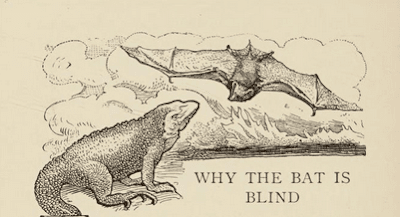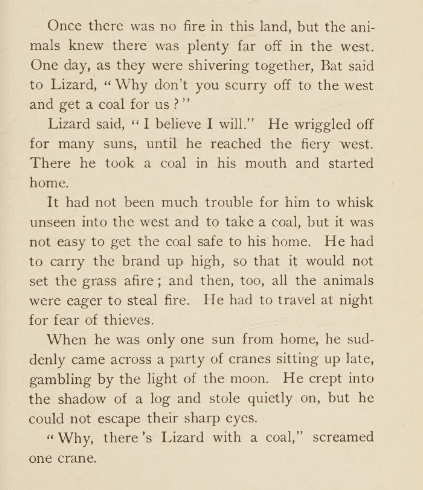Today's blog also could be called "Going Batty."
A group where I enjoy telling asked me to return with some more "spooky, but not too scary tales." They always end their sessions with extra time to make a craft. There are lots of crafts for bats. You might start, as I did, with https://www.redtedart.com/bat-crafts-kids/. I know this group loves individualizing whatever it makes and there are plenty of possibilities there. I don't want to give away which craft I plan to offer at this point, but what you might choose is up to you.
When I went looking for bat stories in the public domain I found Katherine Chandler's 1905 book of varied pourquois tales, In the Reign of Coyote. She retold stories from the Pacific Coast of the U.S. This is a story from California's Native Americans found in papers by Albert Samuel Gatschet in The United States Geographical and Geological Survey of the Rocky Mountain Region Contributions to North American Ethnology.
The word "pitch" is critical to the story and I suspect most of my listeners won't be familiar with it. It has many meanings (see https://www.merriam-webster.com/dictionary/pitch) and while tar might seem the most common as it's used in the story, in thinking about how this is a story with all animal characters, I will use the word and then say Lizard used the sap or resin from a nearby pine tree. It's one of the definitions and seems the most logical.
That might not seem to fit the "spooky, but not too scary tales" requirement, but I plan to follow it up with a story of "The Bloody Vampire." Colleague and friend, Richard Martin has it on his website -- which is jam-packed with material.
It's only 2 minutes long & Richard tells it with great style!
As Richard points out, it's " A great tale, and not just for Hallowe’en: it makes a good encore at any time"
Richard beyond his website mentioned his source: an anonymous 11-year old. Stories traveling is called folklore and this little tale is a perfect example.
Whenever I do a "Keeping the Public in Public Domain" story I always add on a standard list of resources. You will find Richard is indeed among them.
****************
This is part of a series of postings of stories under the category, "Keeping the Public in Public Domain." The idea behind Public Domain was to preserve our cultural heritage after the authors and their immediate heirs were compensated. I feel strongly current copyright law delays this intent on works of the 20th century. My own library of folklore includes so many books within the Public Domain I decided to share stories from them. I hope you enjoy discovering new stories.
At the same time, my own involvement in storytelling regularly creates projects requiring research as part of my sharing stories with an audience. Whenever that research needs to be shown here, the publishing of Public Domain stories will not occur that week. This is a return to my regular posting of a research project here. (Don't worry, this isn't dry research, my research is always geared towards future storytelling to an audience.) Response has convinced me that "Keeping the Public in Public Domain" should continue along with my other postings as often as I can manage it.
Other Public Domain story resources I recommend-
There are many online resources for Public Domain stories, maybe none for folklore is as ambitious as fellow storyteller, Yoel Perez's database, Yashpeh, the International Folktales Collection. I have long recommended it and continue to do so. He has loaded Stith Thompson's Motif Index into his server as a database so you can search the whole 6 volumes for whatever word or expression you like by pressing one key. http://folkmasa.org/motiv/motif.htm
You may have noticed I'm no longer certain Dr. Perez has the largest database, although his offering the Motif Index certainly qualifies for those of us seeking specific types of stories. There's another site, FairyTalez claiming to be the largest, with "over 2000 fairy tales, folktales, and fables" and they are "fully optimized for phones, tablets, and PCs", free and presented without ads.
Between those two sites, there is much for story-lovers, but as they say in infomercials, "Wait, there's more!"





No comments:
Post a Comment